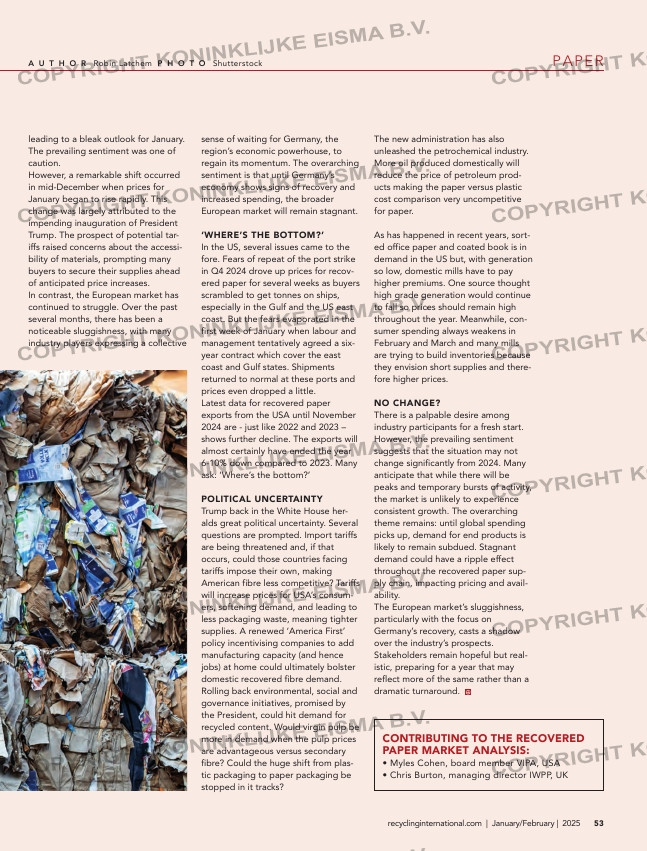Page 53 from: Recycling International Jan/Feb 2025

PAPER
Caution despite
brief surge
53recyclinginternational.com | January/February | 2025
CONTRIBUTING TO THE RECOVERED
PAPER MARKET ANALYSIS:
• Myles Cohen, board member VIPA, USA
• Chris Burton, managing director IWPP, UK
The new administration has also
unleashed the petrochemical industry.
More oil produced domestically will
reduce the price of petroleum prod-
ucts making the paper versus plastic
cost comparison very uncompetitive
for paper.
As has happened in recent years, sort-
ed office paper and coated book is in
demand in the US but, with generation
so low, domestic mills have to pay
higher premiums. One source thought
high grade generation would continue
to fall so prices should remain high
throughout the year. Meanwhile, con-
sumer spending always weakens in
February and March and many mills
are trying to build inventories because
they envision short supplies and there-
fore higher prices.
NO CHANGE?
There is a palpable desire among
industry participants for a fresh start.
However, the prevailing sentiment
suggests that the situation may not
change significantly from 2024. Many
anticipate that while there will be
peaks and temporary bursts of activity,
the market is unlikely to experience
consistent growth. The overarching
theme remains: until global spending
picks up, demand for end products is
likely to remain subdued. Stagnant
demand could have a ripple effect
throughout the recovered paper sup-
ply chain, impacting pricing and avail-
ability.
The European market’s sluggishness,
particularly with the focus on
Germany’s recovery, casts a shadow
over the industry’s prospects.
Stakeholders remain hopeful but real-
istic, preparing for a year that may
reflect more of the same rather than a
dramatic turnaround.
sense of waiting for Germany, the
region’s economic powerhouse, to
regain its momentum. The overarching
sentiment is that until Germany’s
economy shows signs of recovery and
increased spending, the broader
European market will remain stagnant.
‘WHERE’S THE BOTTOM?’
In the US, several issues came to the
fore. Fears of repeat of the port strike
in Q4 2024 drove up prices for recov-
ered paper for several weeks as buyers
scrambled to get tonnes on ships,
especially in the Gulf and the US east
coast. But the fears evaporated in the
first week of January when labour and
management tentatively agreed a six-
year contract which cover the east
coast and Gulf states. Shipments
returned to normal at these ports and
prices even dropped a little.
Latest data for recovered paper
exports from the USA until November
2024 are – just like 2022 and 2023 –
shows further decline. The exports will
almost certainly have ended the year
6-10% down compared to 2023. Many
ask: ‘Where’s the bottom?’
POLITICAL UNCERTAINTY
Trump back in the White House her-
alds great political uncertainty. Several
questions are prompted. Import tariffs
are being threatened and, if that
occurs, could those countries facing
tariffs impose their own, making
American fibre less competitive? Tariffs
will increase prices for USA’s consum-
ers, softening demand, and leading to
less packaging waste, meaning tighter
supplies. A renewed ‘America First’
policy incentivising companies to add
manufacturing capacity (and hence
jobs) at home could ultimately bolster
domestic recovered fibre demand.
Rolling back environmental, social and
governance initiatives, promised by
the President, could hit demand for
recycled content. Would virgin pulp be
more in demand when the pulp prices
are advantageous versus secondary
fibre? Could the huge shift from plas-
tic packaging to paper packaging be
stopped in it tracks?
A U T H O R Robin Latchem P H O T O Shutterstock
As December 2024 began, the global
secondary paper market faced signifi-
cant challenges, particularly for mills in
the Far East. Reports indicated that
many of these mills were aggressively
pushing prices down, creating a diffi-
cult environment for suppliers and
traders alike. Orders were scarce,
leading to a bleak outlook for January.
The prevailing sentiment was one of
caution.
However, a remarkable shift occurred
in mid-December when prices for
January began to rise rapidly. This
change was largely attributed to the
impending inauguration of President
Trump. The prospect of potential tar-
iffs raised concerns about the accessi-
bility of materials, prompting many
buyers to secure their supplies ahead
of anticipated price increases.
In contrast, the European market has
continued to struggle. Over the past
several months, there has been a
noticeable sluggishness, with many
industry players expressing a collective
52-53_mapaper.indd 53 29-01-2025 11:33



